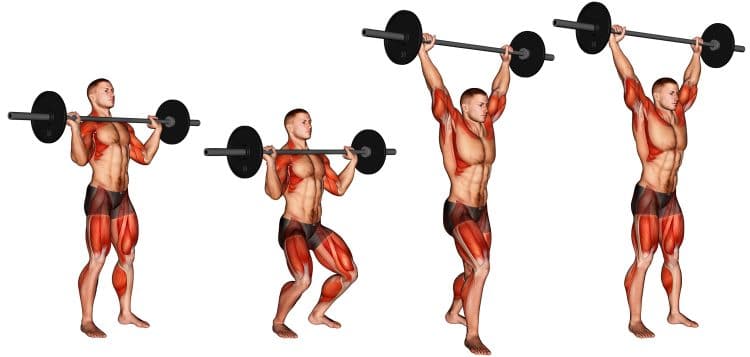If you like lifting weights, you probably have at least a passing interest in one or more of the strength sports: bodybuilding, powerlifting, strongman, or Olympic weightlifting.
While each one involves lifting heavy stuff, the rules, techniques, and even some of the exercises that are part of each one are often quite different.
Take strongman, for example; that’s the only sport where you might find yourself carrying something like an anvil for distance. In contrast, bodybuilders use weights as tools to build bigger muscles and aren’t judged on how strong they are.
Olympic weightlifting is arguably the most explosive of the strength sports. Weights are lifted incredibly quickly using techniques that are, frankly, almost gymnastic. The snatch and the clean and jerk require and develop incredible mobility and flexibility as well as power and strength.
CrossFit “borrows” elements from all the strength sports, including Olympic weightlifting. That’s why you may have seen things like cleans and snatches in some of the Workouts of the Day (WODs).
One exercise that crops up from time to time is the split jerk. A fundamental part of the clean and jerk, this technically demanding exercise turns the overhead press into a full-body exercise.
Level Up Your Fitness: Join our 💪 strong community in Fitness Volt Newsletter. Get daily inspiration, expert-backed workouts, nutrition tips, the latest in strength sports, and the support you need to reach your goals. Subscribe for free!
While it’s not much use to bodybuilders, the split jerk is occasionally used by some strongman competitors during the log press and other overhead pressing exercises.
So, whether you are a CrossFitter, strongman competitor, budding CrossFitter, or athlete looking to increase total body strength and power, learning the split jerk may help you on your journey for greatness.
In this article, we explain why and how to do the split jerk and reveal the seven best variations and alternatives.
Split Jerk – Muscles Worked
The split jerk is a compound exercise. That means it involves several muscles and joints working together. In fact, the split jerk is really a full-body exercise, so the list of muscles worked is pretty long!

The main muscles involved in the split jerk are:
Deltoids – known as your delts for short, these are your major shoulder muscles. There are three sets of deltoid fibers, called heads: anterior (front), medial (side), and posterior (rear). All three groups of deltoid fibers are involved in the split jerk, but the anterior is most dominant. Medial and posterior mostly work as stabilizers.
Triceps – located on the back of your upper arm, the triceps are responsible for extending your elbows. During split jerks, you’ll be using your triceps to help you lock your arms straight.
Trapezius and rhomboids – covering your upper back between and across your shoulder blades, the trapezius stabilizes your shoulder girdle during split jerks. There main job is to hold your shoulders down and back.
Core – the collective term for the muscles of your midsection, the core acts like a weightlifting belt to stabilize your lumbar spine during split jerks. The core muscles are rectus abdominis, the obliques, transverse abdominis, and erector spinae.
Gluteus maximus – known as the glutes for short, this is the largest muscle in the human body. Located on the rear of your hip, it’s responsible for the extension of your hip.
Abductors – located on the outside of your hip, the abductors are the gluteus minimus, gluteus medius, and tensor fascia latae. These muscles help stabilize your hips and stop your knees from collapsing inward during split jerks.
Adductors – the three adductors are longus, brevis, and magnus. Located on the inside of your thighs, the adductors stabilize your hips and stop your knees from falling outward during split jerks.
Quadriceps – the four quadriceps are rectus femoris, vastus lateralis, vastus medialis, and vastus intermedius. Located on the front of your thigh, these muscles work together to extend your knees.
Hamstrings – located on the back of your thigh, the hamstrings flex your knee and, working with the glutes, extend your hips. The three hamstrings are the biceps femoris, semimembranosus, and semitendinosus.
How to Do the Split jerk
Get more from split jerks while keeping your risk of injury to a minimum by following these guidelines:
- Rack and hold a barbell across the front of your shoulders using a slightly wider than shoulder-width grip. Your elbows should be in front of the bar, and the bar itself should rest on your upper chest/anterior deltoids.
- Stand with your feet about hip-width apart. Brace your core and pull your shoulders down and back. Lift your chest.
- Keeping your torso upright and your heels on the floor, bend your legs and descend into a quarter-depth squat.
- Extend your hips and legs explosively and push the bar up and overhead.
- Simultaneously drive one leg forward and one leg back to land in a split stance beneath the bar, arms fully extended.
- Bring your front foot back and then your rear foot forward so you are standing with your feet together and your arms extended overhead.
- Lower the bar back to your shoulders and repeat.
Split Jerk Benefits and Drawbacks
Does the split jerk deserve a place in your workouts? Consider these benefits and then decide!
A full-body exercise – overhead pressing typically only involves your upper body. Even standing presses involve minimal lower body engagement. The split jerk combines a dynamic lunge with an overhead press, making it a full-body exercise.
Improves coordination and timing – the split jerk is as much about timing and coordination as it is muscle strength and power. Doing this exercise will enhance balance, athleticism, and agility, making it a helpful exercise for all sports.
Develops power – power is your ability to generate force quickly. It’s a critical part of most sports. If you want to run faster, jump higher, or punch harder, the split jerk could help.
A part of Olympic weightlifting – in Olympic lifting, the split jerk is usually preceded by a clean. As such, if you want to train for the clean and jerk, you need to master both parts of the movement. It’s common to train the jerk separately as it’s often the weakest part of the lift.
While split jerks are a mostly beneficial exercise, there are also a few drawbacks to consider:
Hard to learn – there aren’t many overhead pressing exercises that are more technically challenging than the split jerk. As such, it’s not an easy lift to learn and master and not suitable for beginners.
Risk of injury – the combination of heavy weights and rapid movements means that the split jerk could cause serious injury. Therefore, it is essential to warm up thoroughly before doing this exercise and perform it with good form. Even then, there is still a risk of injury.
Not so good for hypertrophy – while the split jerk allows you to lift heavy weights, using your legs means there is less load on your upper body than other types of overhead press. As such, if you are pressing for bigger delts, this exercise may not be your best choice.
7 Split Jerk Variations and Alternatives
Split jerks are a highly effective full-body exercise, but that doesn’t mean you need to do it all the time. It may not even be appropriate for your training goals. There are several variations and alternatives you can use to keep your workouts productive and interesting:
Level Up Your Fitness: Join our 💪 strong community in Fitness Volt Newsletter. Get daily inspiration, expert-backed workouts, nutrition tips, the latest in strength sports, and the support you need to reach your goals. Subscribe for free!
1. Push jerk
The push-jerk is a slightly simplified version of the split jerk. Instead of receiving the bar in a lunge position, you drop into a shallow overhead squat. This requires a little less balance and coordination, making it a more accessible exercise for some lifters. There is also less of a balance component to this exercise.
How to do it:
- Stand with your feet between shoulder and hip-width apart.
- Using an overhand grip, rack and hold your barbell across the front of your shoulders. Your hands should be just outside shoulder-width apart. Raise your elbows slightly so they are in front of the bar.
- Brace your core, pull your shoulders down and back, and lift your chest.
- Without leaning forward, bend (dip) your knees and descend into a quarter-depth squat. Imagine you are setting up for a jump. Keep your heels on the floor.
- Extend your legs and use this momentum to help you drive the bar up and off your shoulders. Rise up unto your toes if you wish.
- Bend your knees again as you extend your arms and catch the bar in a partial squat with your arms straight.
- Stand up and hold the bar overhead with your knees, hips, and shoulders extended.
- Lower the bar back to your shoulders and repeat.
2. Push press
Like the push jerk, the push press involves using your legs to help you drive the weight up and overhead. However, there is no requirement to re-bend your knees to receive the bar. Instead, you should catch the bar with your legs extended. This exercise is more straightforward than either the split or push jerk.
How to do it:
- Stand with your feet between shoulder and hip-width apart.
- Using an overhand grip, rack and hold your barbell across the front of your shoulders. Your hands should be just outside shoulder-width apart. Raise your elbows slightly so they are in front of the bar.
- Brace your core, pull your shoulders down and back, and lift your chest.
- Without leaning forward, bend your knees and descend into a quarter-depth squat. Imagine you are setting up for a jump. Keep your heels on the floor.
- Rapidly extend your knees and hips and use this momentum to help you drive the bar up and overhead.
- Receive the bar overhead with your knees, hips, and arms extended.
- Lower the bar back to your shoulders and repeat.
3. Overhead lunge
Dropping into a lunge with a weight above your head can be unnerving. It’ll test your balance, coordination, and flexibility. Overhead lunges provide a way to get used to this movement without having to descend so quickly.
How to do it:
- Hold a barbell overhead using a slightly wider than shoulder-width, overhand grip. Pull your shoulders down and back and brace your core. Stand with your feet together.
- Step forward and then bend your legs, lowering your rear knee down to within an inch of the floor. Do not let your front knee travel in front of your toes.
- Push off your rear leg and step through into another lunge.
- Continue alternating legs until you have covered the required number of reps or distance.
- You can also do alternating forward lunges or lunges to the rear. This exercise can be done with dumbbells if preferred.
4. Thruster
Just like split jerks, push jerks, and push presses, the thruster involves using your legs to help you press a weight up and overhead. However, your tempo is slower with this exercise, and the leg movement is larger, increasing lower body engagement. This exercise works all the same muscles as split jerks but is much less complex.
How to do it:
- Stand with your feet shoulder-width apart, toes turned slightly outward. Rack and hold a barbell across the front of your shoulders, with your upper arms roughly parallel to the floor. Your hands should be just outside shoulder-width apart. Brace your core.
- Bend your knees and squat down until your thighs are roughly parallel to the floor. Do not round your lower back, but feel free to descend deeper if your flexibility and knee health allow. Your torso should remain relatively upright.
- Stand up quickly and use this momentum to help you push the barbell up and overhead to arms’ length.
- Lower the bar back down to the front rack position, descend into another squat, and repeat.
This exercise can also be done using dumbbells or kettlebells instead of a barbell.
5. Waiter’s walk
The waiter’s walk involves carrying a barbell or dumbbells overhead. While this exercise doesn’t look much like the split jerk, it still works many of the same muscles. This makes it a good movement for increasing shoulder stability and core strength, both of which are prerequisites of the split jerk.
How to do it:
- Clean and press two dumbbells or kettlebells overhead. Brace your core and activate your shoulders to keep the weights stable.
- Keeping your arms vertical, walk around your training area for the prescribed time or distance.
- Carefully lower the weights to your shoulders and then to the floor, rest, and repeat.
- This exercise can also be done using a barbell.
- You can also do this exercise using one dumbbell or kettlebell, which increases core engagement.
6. Strict standing overhead press
As its name suggests, the strict standing overhead press is done without any assistance from your legs. Instead, your legs remain rigid, and your upper body does all the work. The strict standing overhead press is sometimes called the military press.
The difference between military presses and regular overhead presses is that the former are done with your heels together like you are standing to attention. However, it’s usually more comfortable and stable to do strict presses with your feet shoulder to hip-width apart. Try both and see which you prefer.
The strict standing overhead press is the cornerstone of all overhead pressing exercises. As such, it’s the one that most people need to learn and master before progressing to the push press, thruster, push jerk, and split jerk,
How to do it:
- Stand with your feet between shoulder and hip-width apart, or together if you want to do military presses.
- Using an overhand grip, rack and hold your barbell across the front of your shoulders. Your hands should be just outside shoulder-width apart. Raise your elbows slightly so they are in front of the bar.
- Brace your core, pull your shoulders down and back, and lift your chest.
- Without bending your knees, press the weight up and overhead to arms’ length.
- Lower the bar back to your shoulders and repeat.
7. Seated dumbbell overhead press
If you are new to overhead pressing and find it hard to separate your legs from your upper body, the most obvious solution is to press while seated. This completely removes your legs from the exercise so you can focus on strengthening your upper body.
Dumbbell overhead presses are arguably more forgiving and shoulder-friendly than barbell presses. That’s because they allow you to move your arms independently and choose your own unique movement path.
You can do seated dumbbell overhead presses with or without back support and with a palms-forward or neutral grip as preferred.
Read how to do seated, unsupported, overhead dumbbell presses here, and neutral grip dumbbell overhead presses here.
Split Jerk Guide – Wrapping Up
While the split jerk probably isn’t much use to bodybuilders, for athletes and CrossFitters, it could be a valuable exercise.
The split jerk is a part of the clean and jerk in Olympic weightlifting and provides an efficient way to lift heavy weights overhead. You use your legs to assist your arms, so you can press bigger loads. It’s also a valuable tool for building explosive power, speed, balance, and agility, all of which are important in sports.
On the downside, it’s a tricky exercise to learn and master and is probably too technical for beginners. That said, there are plenty of similar and simpler exercises you can do that work the same muscles, including the push press and overhead lunges.
It’s best to use light weights when learning this exercise until you are confident that you can do it correctly. Losing your balance during a deep lunge and with a heavy barbell overhead is a recipe for injury! But, with practice, you’ll soon be lifting big weights with one of the most impressive overhead pressing exercises around.
Interested in measuring your progress? Check out our strength standards for Overhead Squat, Clean and Press, Push Press, and more.








